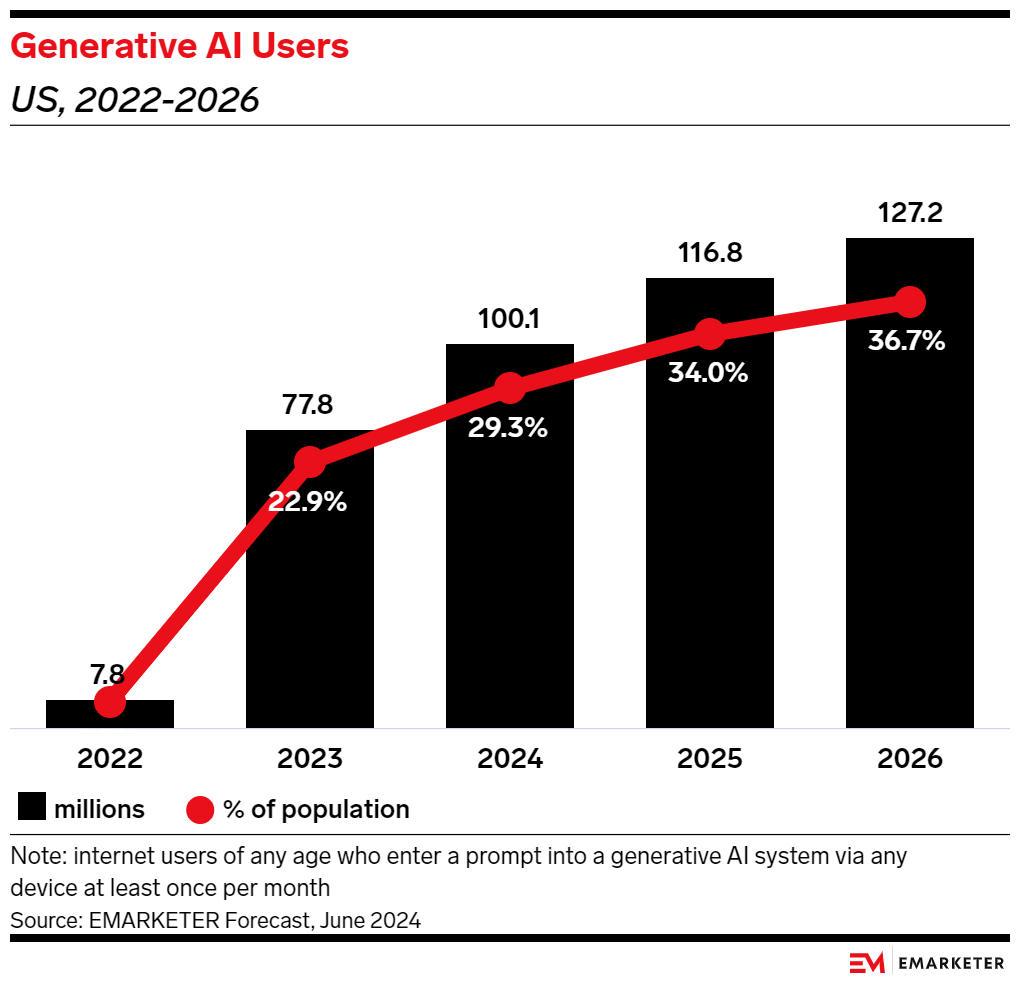The rapid adoption of generative AI is revolutionizing the retail and e-commerce landscape. In 2024, an astounding 100.1 million people in the US will use generative AI at least once per month, marking a nearly 900% increase from 2022. This trend highlights a significant shift in consumer behavior and presents an unparalleled opportunity for brands to enhance their marketing strategies, improve customer service, and optimize operations. In this blog, we explore why the adoption of generative AI by consumers is crucial for retail and e-commerce brands and how they can leverage this technology to drive revenue and stay competitive in a dynamic market.
Key Statistics:
- 100.1 million people in the US will use generative AI at least once per month in 2024, a nearly 900% increase from 7.8 million in 2022 (June 2024 forecast).
- 32.6% of US internet users will be generative AI users this year.
- Google integrating generative AI into search means many users engage with this technology without realizing it, suggesting a seamless integration into daily internet use.
- Nearly half of generative AI use will be driven by workplace adoption by 2026 (GenAI User Forecast 2024 report).

The Case for Generative AI Implementations
The rapid adoption of generative AI by consumers is a significant opportunity for retail and e-commerce brands. Here's why:
-
Enhanced Customer Engagement and Personalization:
- Personalized Marketing Campaigns: Generative AI can analyze vast amounts of customer data to create highly personalized marketing campaigns. By understanding individual preferences and behaviors, brands can tailor their messaging to resonate more effectively with consumers, leading to higher engagement rates and increased sales.
- Dynamic Content Creation: Retailers can use generative AI to create dynamic, customized content for their websites, emails, and social media platforms. This can range from personalized product recommendations to customized promotional offers, enhancing the customer experience and driving conversions.
-
Improved Customer Service and Support:
- AI-Powered Chatbots: Integrating generative AI into customer service platforms allows for the creation of sophisticated chatbots that can handle a wide range of customer inquiries, providing quick and accurate responses. This improves customer satisfaction and frees up human resources for more complex issues.
- Virtual Shopping Assistants: AI can act as virtual shopping assistants, helping customers find products, suggesting items based on previous purchases, and providing real-time assistance during the shopping journey.
-
Operational Efficiency:
- Inventory Management: Generative AI can predict inventory needs more accurately by analyzing sales data and market trends. This reduces overstock and stockouts, optimizing the supply chain and reducing costs.
- Demand Forecasting: AI algorithms can forecast demand for products, allowing retailers to adjust their strategies proactively, ensuring they meet customer needs without incurring unnecessary expenses.
-
Competitive Advantage:
- Innovation and Differentiation: Early adopters of generative AI can differentiate themselves from competitors by offering innovative solutions and personalized experiences. This can attract new customers and retain existing ones.
- Market Insights: AI can analyze market trends and consumer sentiment in real time, providing brands with valuable insights to adjust their strategies and stay ahead of the competition.
How Retailers and E-commerce Brands Can Take Advantage of Generative AI to Drive Revenue
-
Develop Personalized Marketing Strategies:
- Utilize generative AI to segment customers based on their behavior and preferences, creating targeted marketing campaigns that speak directly to individual needs and desires.
- Implement AI-driven content creation tools to generate personalized emails, product recommendations, and advertisements that resonate with customers on a personal level.
-
Integrate AI into Customer Service:
- Deploy AI-powered chatbots and virtual assistants to handle customer inquiries, provide personalized shopping advice, and enhance the overall shopping experience.
- Use AI to analyze customer feedback and sentiment, allowing for continuous improvement in customer service and product offerings.
-
Optimize Inventory and Supply Chain Management:
- Leverage AI to predict inventory needs, reducing waste and ensuring that popular items are always in stock.
- Use generative AI for demand forecasting, allowing for better planning and resource allocation.
-
Train Staff to Use Generative AI:
- Invest in training programs to ensure staff members are proficient in using generative AI tools and technologies.
- Encourage a culture of innovation where employees are empowered to experiment with AI solutions to improve business processes and customer experiences.
Conclusion
The widespread adoption of generative AI presents a transformative opportunity for retail and e-commerce brands. By harnessing the power of AI for personalized marketing, improved customer service, operational efficiency, and competitive advantage, businesses can drive revenue growth and enhance customer satisfaction. Training staff to effectively use these technologies will be crucial in realizing the full potential of generative AI and staying ahead in a rapidly evolving market.
This article was based on stats shared in Insider Intelligence here.